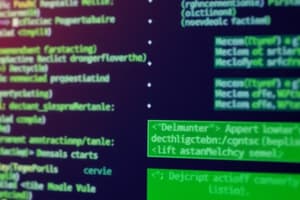Podcast
Questions and Answers
Which of the following best illustrates the scope of the 'problem domain' in the context of systems analysis and design?
Which of the following best illustrates the scope of the 'problem domain' in the context of systems analysis and design?
- All possible technical challenges encountered during software development.
- The specific area of the users’ business need that is within the scope of the new system. (correct)
- The entirety of the IT department's responsibilities within an organization.
- The complete software infrastructure required to run a business.
A company is developing a new inventory management system. Which of the following would MOST accurately be modeled as a domain class?
A company is developing a new inventory management system. Which of the following would MOST accurately be modeled as a domain class?
- A user interface screen for entering new products.
- An individual product with its attributes and behaviors. (correct)
- The algorithm used to calculate reorder points.
- A database table storing product information.
In the context of domain classes, what is the PRIMARY benefit of ensuring each class accurately represents a real-world concept or object?
In the context of domain classes, what is the PRIMARY benefit of ensuring each class accurately represents a real-world concept or object?
- It provides clarity about the key components of the system and how they relate to each other. (correct)
- It simplifies the process of writing code by reducing the number of classes.
- It automatically optimizes database performance.
- It ensures compatibility with legacy systems.
Why is maintaining data integrity a crucial aspect of properly defining domain classes?
Why is maintaining data integrity a crucial aspect of properly defining domain classes?
How do domain classes primarily influence the design phase of a software development project?
How do domain classes primarily influence the design phase of a software development project?
Consider a library management system. Which of the following would be the MOST appropriate set of domain classes to model?
Consider a library management system. Which of the following would be the MOST appropriate set of domain classes to model?
In a system designed for a university, which of the following options contains items that would ALL be viable candidates for domain classes?
In a system designed for a university, which of the following options contains items that would ALL be viable candidates for domain classes?
What is the main reason for modelling 'things' as domain classes?
What is the main reason for modelling 'things' as domain classes?
What is the relationship between domain classes and data entities?
What is the relationship between domain classes and data entities?
What could be considered NOT an importance of Domain Classes
What could be considered NOT an importance of Domain Classes
During the initial brainstorming phase for identifying domain classes, which action MOST effectively ensures a comprehensive coverage of potential 'things' within the system?
During the initial brainstorming phase for identifying domain classes, which action MOST effectively ensures a comprehensive coverage of potential 'things' within the system?
A project team is using the noun technique to identify potential domain classes. After identifying an initial list of nouns, what is the MOST critical next step to refine this list?
A project team is using the noun technique to identify potential domain classes. After identifying an initial list of nouns, what is the MOST critical next step to refine this list?
When applying the noun technique, a team identifies 'customer address' as a potential domain class. Which question would BEST guide the decision of whether to include this as a separate class or an attribute of the 'Customer' class?
When applying the noun technique, a team identifies 'customer address' as a potential domain class. Which question would BEST guide the decision of whether to include this as a separate class or an attribute of the 'Customer' class?
In which scenario would the noun technique be MOST advantageous compared to brainstorming when identifying domain classes?
In which scenario would the noun technique be MOST advantageous compared to brainstorming when identifying domain classes?
During the refinement stage of the noun technique, a team identifies 'report' as a noun. Which question is MOST relevant to determine whether 'report' should be excluded from the list of potential domain classes?
During the refinement stage of the noun technique, a team identifies 'report' as a noun. Which question is MOST relevant to determine whether 'report' should be excluded from the list of potential domain classes?
In object-oriented programming, what is the significance of an object's attributes in relation to its class?
In object-oriented programming, what is the significance of an object's attributes in relation to its class?
A development team is modeling a library system. They've identified 'Book,' 'Author,' and 'Borrower' as potential domain classes. What is the MOST important consideration when defining the relationships between these classes?
A development team is modeling a library system. They've identified 'Book,' 'Author,' and 'Borrower' as potential domain classes. What is the MOST important consideration when defining the relationships between these classes?
Consider a scenario where two distinct Car objects, car1 and car2, are instantiated from the same Car class, what will be the difference?
Consider a scenario where two distinct Car objects, car1 and car2, are instantiated from the same Car class, what will be the difference?
Within the context of a class representing a Customer, which of the following best exemplifies a compound attribute?
Within the context of a class representing a Customer, which of the following best exemplifies a compound attribute?
Consider a scenario where 'Payment Method' is identified as a noun during system analysis. Which of the following questions would be MOST effective in determining whether it should be treated as a domain class or simply an attribute within another class such as 'Order'?
Consider a scenario where 'Payment Method' is identified as a noun during system analysis. Which of the following questions would be MOST effective in determining whether it should be treated as a domain class or simply an attribute within another class such as 'Order'?
Which of the following represents the MOST significant challenge in applying the noun technique for domain class identification in a complex business system?
Which of the following represents the MOST significant challenge in applying the noun technique for domain class identification in a complex business system?
In a university course registration system, identify the most suitable candidate for an identifier attribute within the Course class.
In a university course registration system, identify the most suitable candidate for an identifier attribute within the Course class.
In the provided Car class example, how might you modify the start method to conditionally initiate the car based on whether the fuel level, represented by the attribute fuel_level, is above a certain threshold?
In the provided Car class example, how might you modify the start method to conditionally initiate the car based on whether the fuel level, represented by the attribute fuel_level, is above a certain threshold?
When deciding to include a noun as a domain class during system analysis, what is the primary rationale for ensuring that 'the system needs to remember more than one of these items'?
When deciding to include a noun as a domain class during system analysis, what is the primary rationale for ensuring that 'the system needs to remember more than one of these items'?
A team is using brainstorming and the noun technique. How can these methods be used together to build a better model?
A team is using brainstorming and the noun technique. How can these methods be used together to build a better model?
In the context of object-oriented design, why is it important to carefully choose attributes for a class?
In the context of object-oriented design, why is it important to carefully choose attributes for a class?
Consider the university course registration system; how would you represent the relationship between a Professor and Course class, considering that a professor can teach multiple courses?
Consider the university course registration system; how would you represent the relationship between a Professor and Course class, considering that a professor can teach multiple courses?
When designing a class, what is the primary reason for defining attributes as private (protected) and providing access through getter and setter methods?
When designing a class, what is the primary reason for defining attributes as private (protected) and providing access through getter and setter methods?
Given a scenario where you need to add functionality to the Car class to include an advanced driver-assistance system (ADAS) without modifying the original class, which object-oriented principle would be most applicable?
Given a scenario where you need to add functionality to the Car class to include an advanced driver-assistance system (ADAS) without modifying the original class, which object-oriented principle would be most applicable?
In the context of the university course registration system, how can polymorphism be effectively utilized when dealing with different types of users (e.g., students, professors, administrators) accessing the system?
In the context of the university course registration system, how can polymorphism be effectively utilized when dealing with different types of users (e.g., students, professors, administrators) accessing the system?
Flashcards
Domain Classes
Domain Classes
Concepts or objects representing key items in a business process.
Problem Domain
Problem Domain
Specific area of users’ business needs within a new system's scope.
Data Entities
Data Entities
A term often synonymous with domain classes indicating real-world concepts.
Attributes
Attributes
Signup and view all the flashcards
Behaviors
Behaviors
Signup and view all the flashcards
Examples of Domain Classes
Examples of Domain Classes
Signup and view all the flashcards
Data Integrity
Data Integrity
Signup and view all the flashcards
Clarity in Systems
Clarity in Systems
Signup and view all the flashcards
Design Guidance
Design Guidance
Signup and view all the flashcards
Things in a System
Things in a System
Signup and view all the flashcards
Objects
Objects
Signup and view all the flashcards
Class Structure
Class Structure
Signup and view all the flashcards
Identifier or Key
Identifier or Key
Signup and view all the flashcards
Compound Attribute
Compound Attribute
Signup and view all the flashcards
Attribute Values
Attribute Values
Signup and view all the flashcards
Instantiating an Object
Instantiating an Object
Signup and view all the flashcards
Car Example
Car Example
Signup and view all the flashcards
Course Registration System
Course Registration System
Signup and view all the flashcards
Brainstorming Technique
Brainstorming Technique
Signup and view all the flashcards
Noun Technique
Noun Technique
Signup and view all the flashcards
Method
Method
Signup and view all the flashcards
Steps in Noun Technique
Steps in Noun Technique
Signup and view all the flashcards
User Involvement
User Involvement
Signup and view all the flashcards
Unique Thing
Unique Thing
Signup and view all the flashcards
Class vs. Object
Class vs. Object
Signup and view all the flashcards
Study Notes
Domain Classes
- Domain class, or data entity, represents a real-world concept in a system.
- Contains both data (attributes) and behaviors (methods).
- Examples: Products, Sales, Shippers, Shipments, Customers, Orders, Students, Grades, Classes, Instructors, Suppliers, Products, Contacts, Restaurants, Menu Items, Customers, Orders, Drivers, Routes, Payments
- Critical to a specific business process.
Identifying Domain Classes
- Brainstorming Technique: Identify user and use cases, brainstorm related "things," systematically explore potential "things" (tangible items, locations, roles), and involve multiple users.
- Noun Technique: Identify nouns in system descriptions, classify as domain classes, attributes, or not needed, refine lists by considering uniqueness, scope, repetition, synonyms, outputs, inputs, and potential future changes.
- Refine lists of nouns, resolve synonyms, and distinguish between things, attributes and system outputs.
Problem Domain "Things"
- A business process is in the specific area of user's business needs.
- "Things" are items users work with; objects representing real-world entities, concepts.
- Examples of "things": Products, sales, shippers, customers, invoices, payments, etc.
- Modeled as domain classes or data entities (called domain classes in this course).
Importance of Domain Classes
- Accurate Representation: Provide an accurate representation of the system's data.
- Clarity: Offer clarity about system components and their relationships.
- Data Integrity: Ensure data consistency by defining data entities correctly.
- Design Guidance: Guide the design of databases, user interfaces, and other system components.
Domain Class Details
- Attributes: Describe information about each class instance.
- Example: Customer with first name, last name, phone number.
- Identifier (Key): Unique attribute identifying each instance.
- Example: Customer ID.
- Compound Attribute: Two or more attributes combined.
- Example: Address.
- Classes and Objects:
- Classes are blueprints, defining attribute and method structure for created objects.
- Objects are specific instances, holding data according to the class's structure.
- Example: A "Car" class could have attributes like color, model, speed, methods like start, stop and objects like myCar (Red Toyota).
- Attributes and Values: Attribute values specify object characteristics.
- Example: car1 (Red Toyota) and car2 (Blue Honda) have different values for the same attributes.
Example: University Course Registration System
- "Things": Students, Courses, Professors, Grades, Enrollments.
- Attributes (Example):
- Student: Student ID, name, completed courses.
- Course: Course code, title, enrolled students.
- Professor: Professor ID, name.
- Grade: Course code, student ID, grade.
- Relationships: Students enroll in courses, professors teach courses, and grades are assigned.
Studying That Suits You
Use AI to generate personalized quizzes and flashcards to suit your learning preferences.




